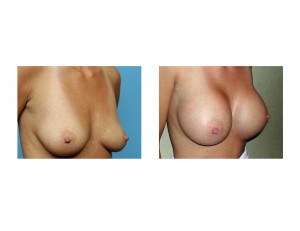
The risk of infection in breast augmentation is estimated to be around 1% which means it is relatively low. Infections will usually occur from days to weeks after surgery. It is possible that it could occur months later, but the inciting event is inadvertent contamination during implant placement. As a result, breast implants infections in cosmetic augmentations are not something that will likely occur many months to years later.
Breast implant infections will present as a warm, swollen and sore breast that appears different than the other. It is exceedingly rare to have both breasts simultaneously infected and I can’t say I have ever heard of it although it is theoretically possible. It will usually catch the patient’s attention as the swelling is going down and then it spontaneously gets swollen again in the involved breast days to weeks after surgery.
The historic thought is that the breast implant with the infection should be removed for resolution. While this would undoubtably solve it, no patients really wants to go to that immediate and drastic approach. Therefore, oral antibiotics are always resumed with a change to a broader spectrum antibiotic. Most of the time, the infectious bacteria is skin-related specifically a Gram-positive organism.
The interesting question is how effective is this approach and what to do if simple oral antibiotics do not provide a solution for the infected breast implant patient. In an excellent article in the April 2010 issue of the journal of Plastic and Reconstructive Surgery, one prominent plastic surgeon reviews his experience with 87 breast implant infections or exposures over a 15 year period. While much of his patient population was in the more challenging breast reconstruction patient, there are some pearls and insights to be gleaned toward the less complicated breast augmentation patient.
The first key is to recognize infection early and start on broader spectrum oral antibiotics in adequate doses. One easily convert a cellulitis (surrounding soft tissue infection) from progressing to an infected fluid collection (seroma or abscess) in the space around the implant. Antibiotics should be continued for two or three weeks.
If this fails to completely eliminate the redness or it returns shortly after being off antibiotics, then a decision has to be made. Should one receive IV antibiotics at home or return to the operating room to washout the breast pocket and completely clean the implant of any biofilm layer. (replace the cleaned implant or to place a new one is, unfortunately an economic decision in elective cosmetic surgery) A thorough scrubbing and soaking of an existing implant in the early management of an infection will usually suffice. That is up to the judgment of the treating plastic surgeon.
Almost all of the time early and aggressive antibiotics, with surgical ‘cleaning’ will provide a relatively prompt solution. Greater long-term problems arise when everyone is in ‘denial’ about the need to be proactive. Allowing infections to progress to implant exposure or draining skin fistulas has far less satisfactory outcomes.
Dr. Barry Eppley
Indianapolis, Indiana


